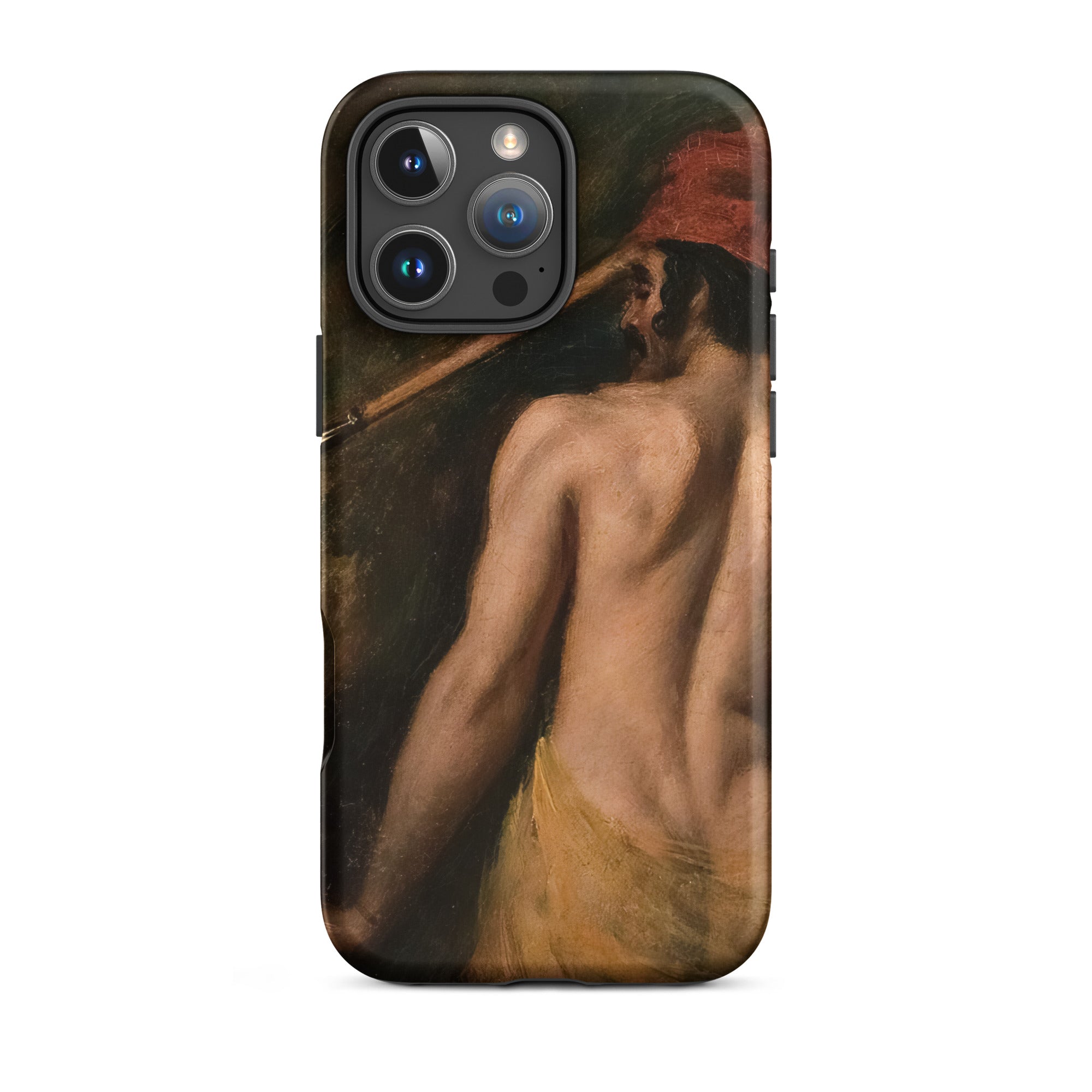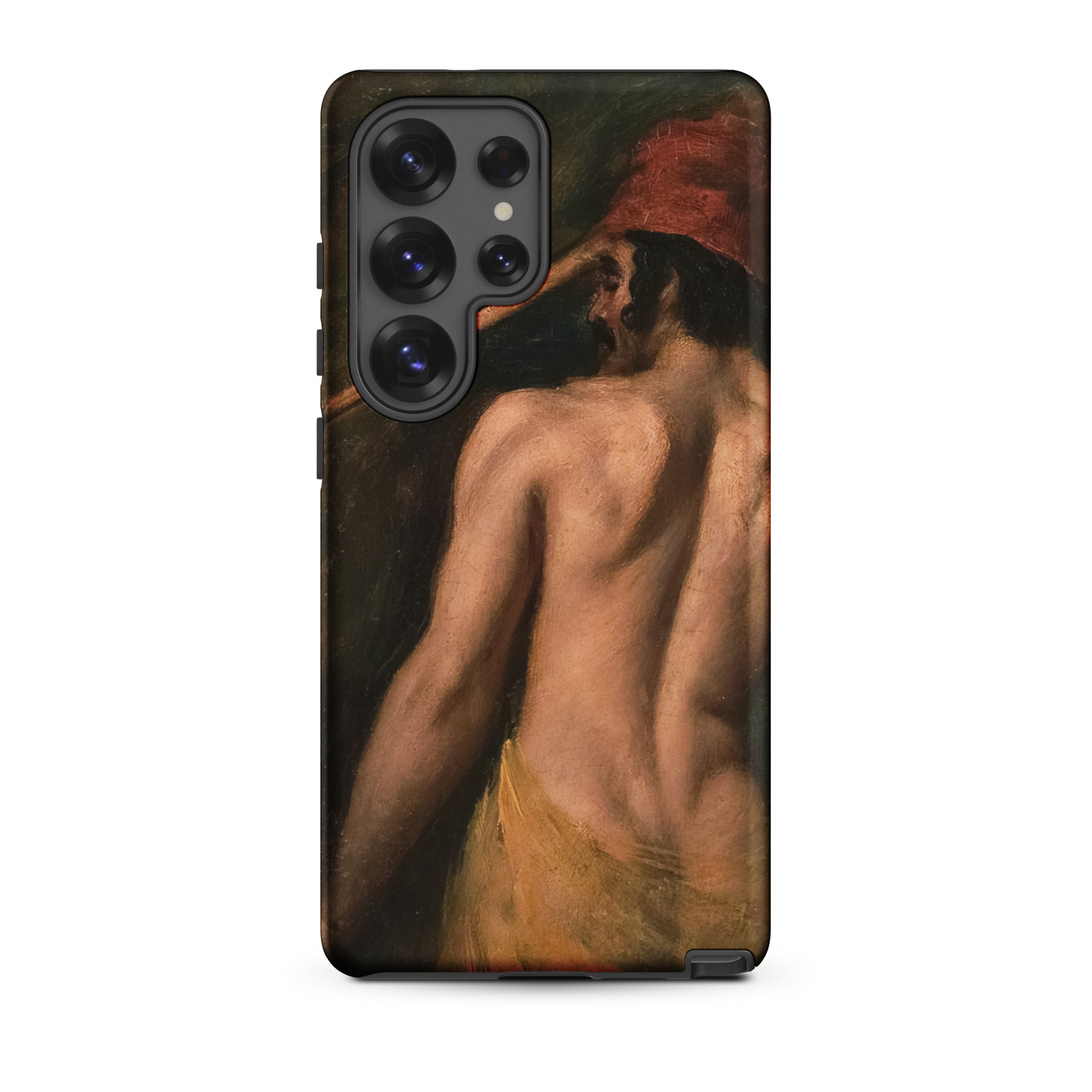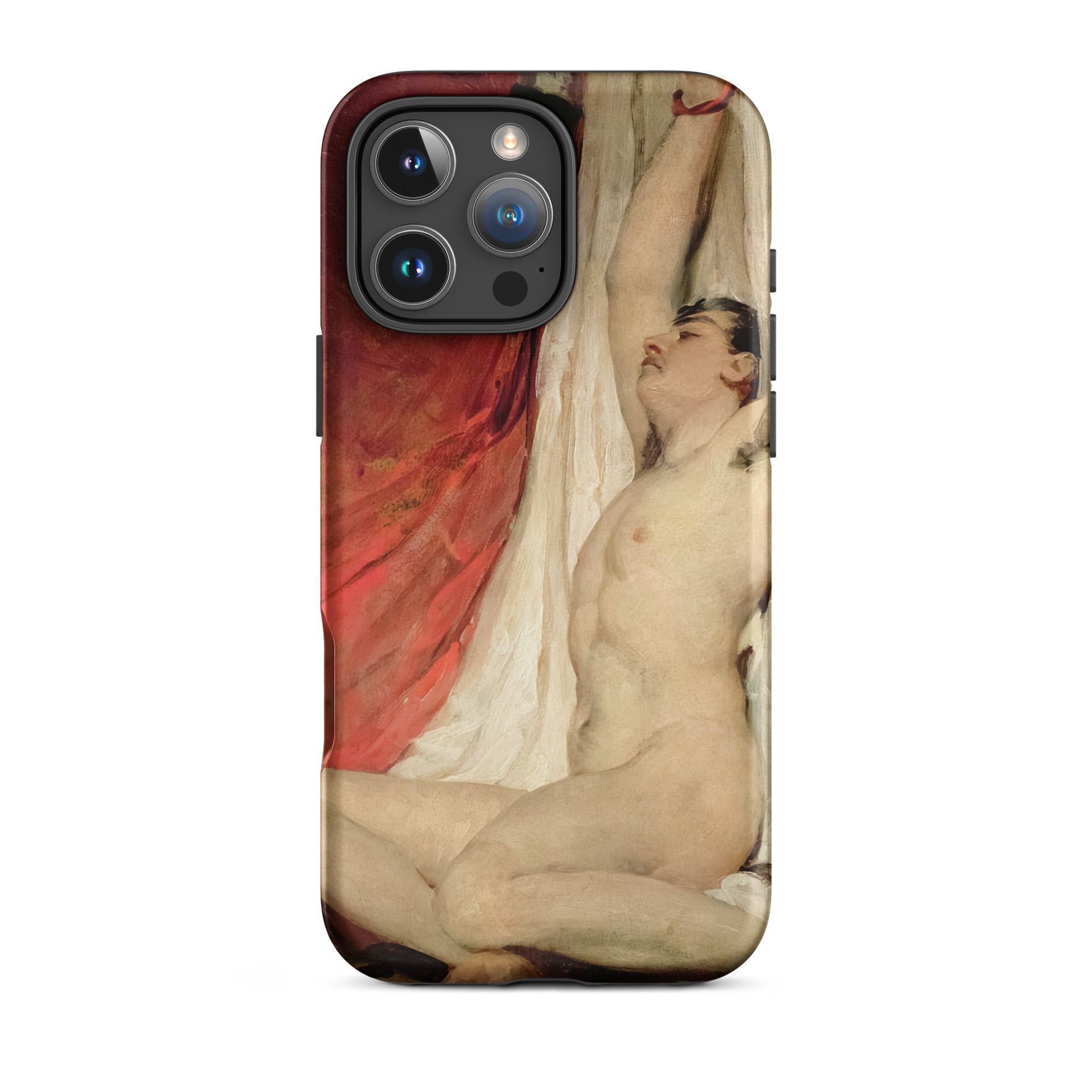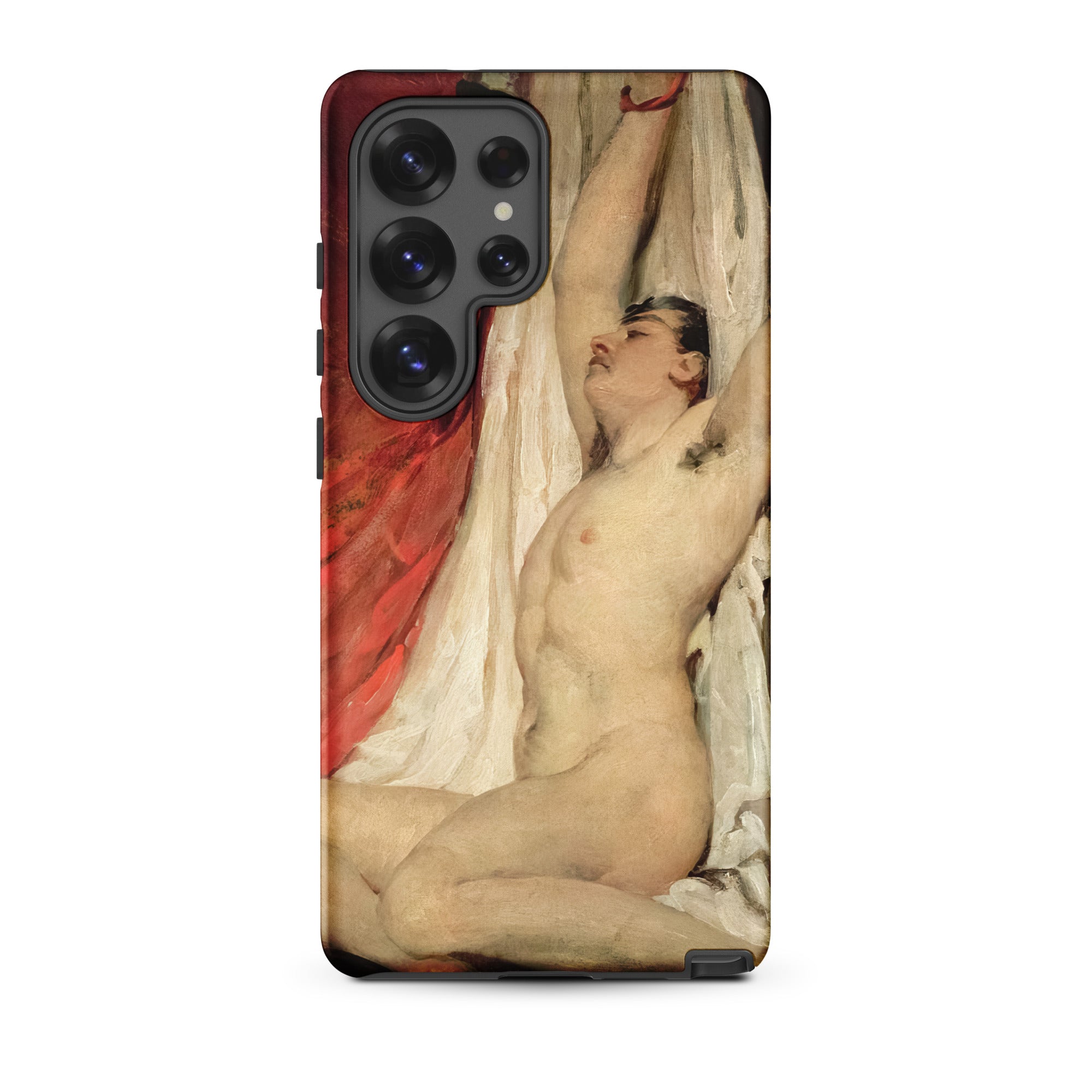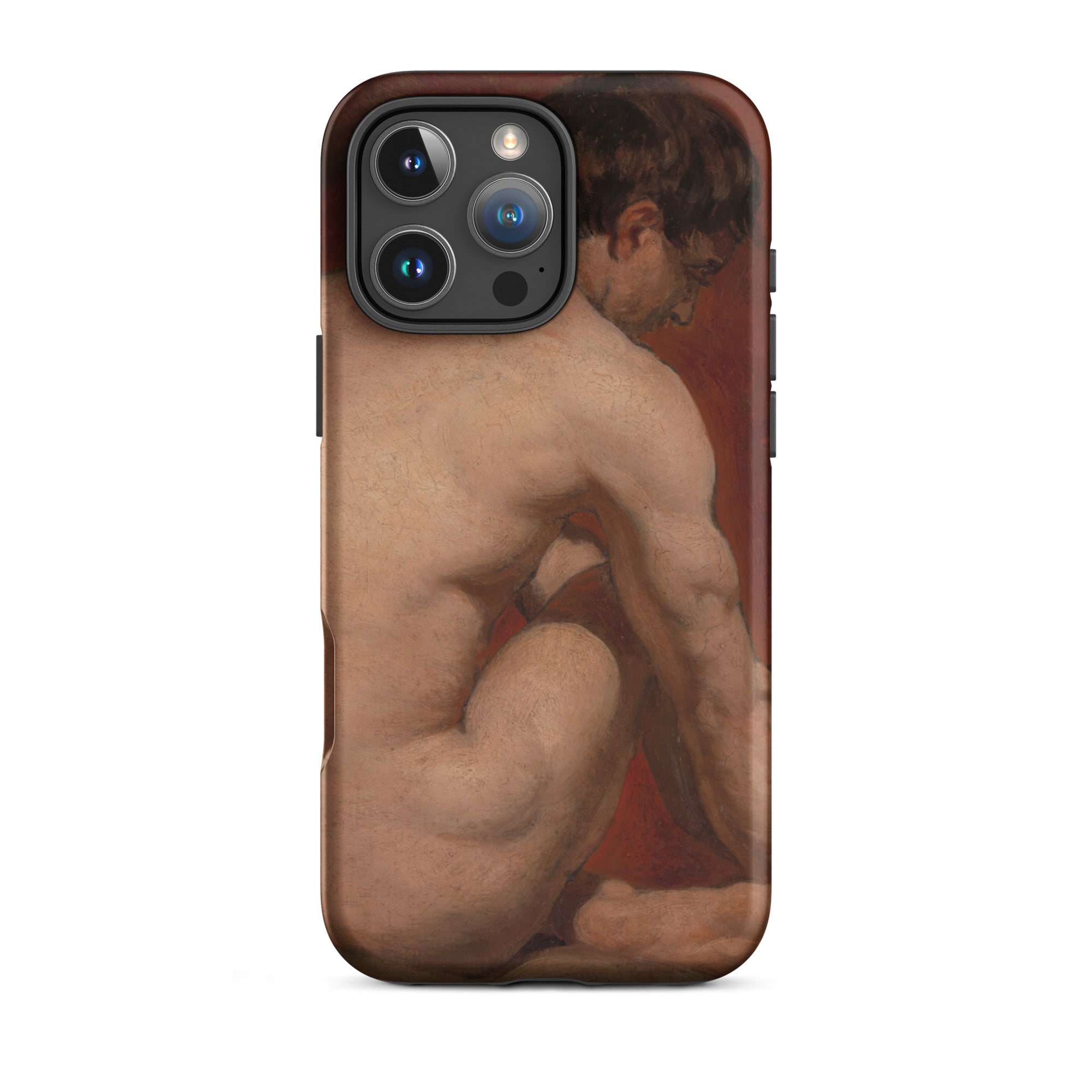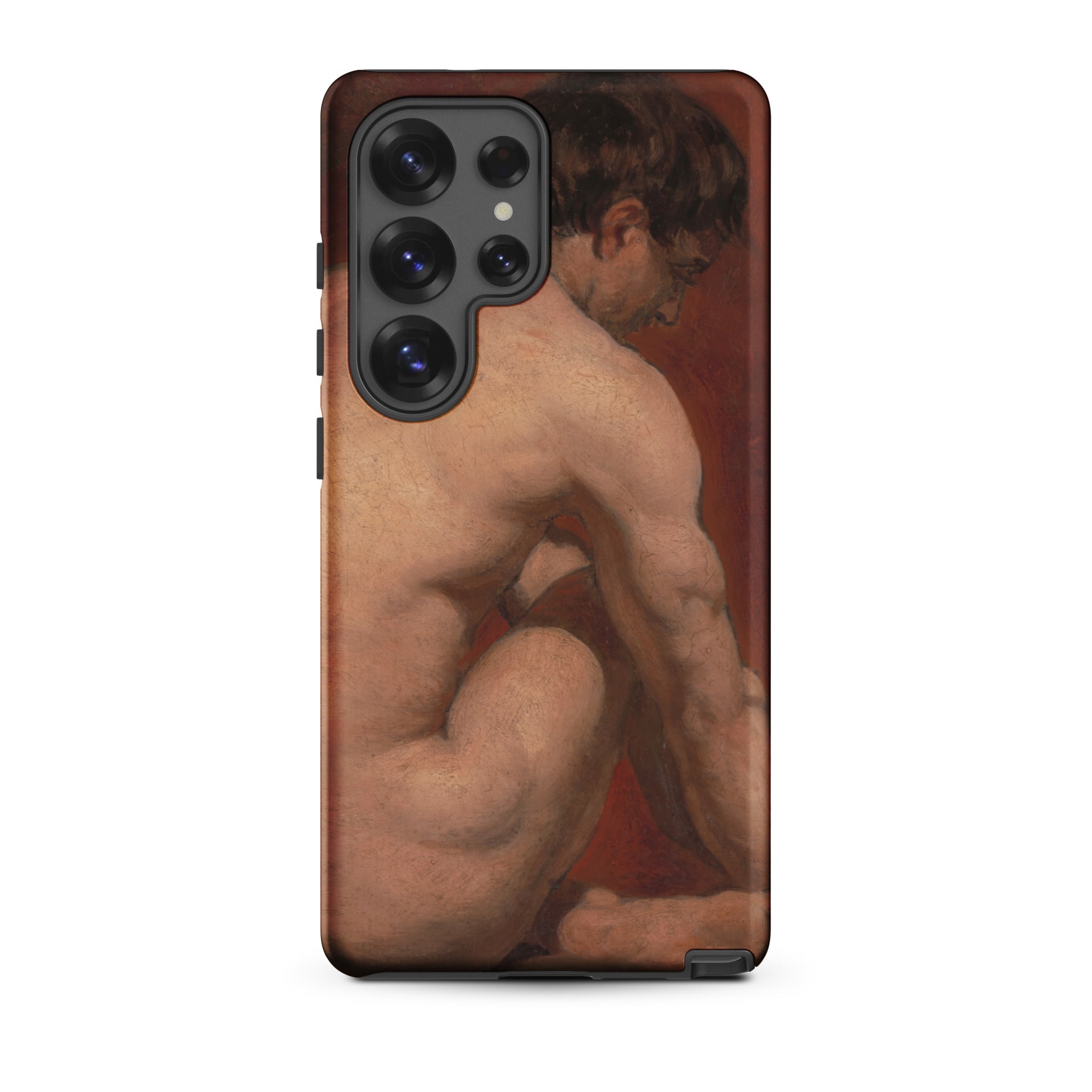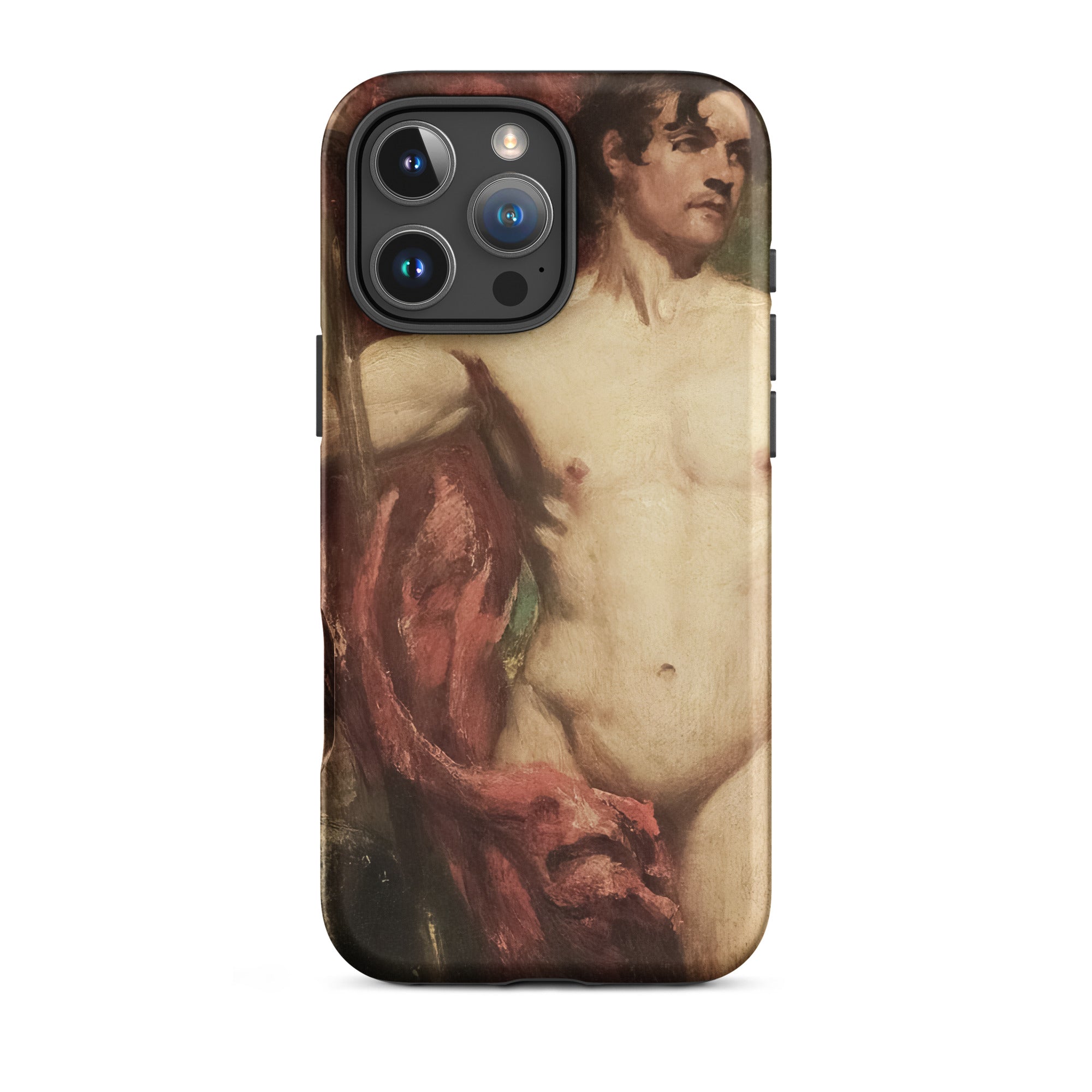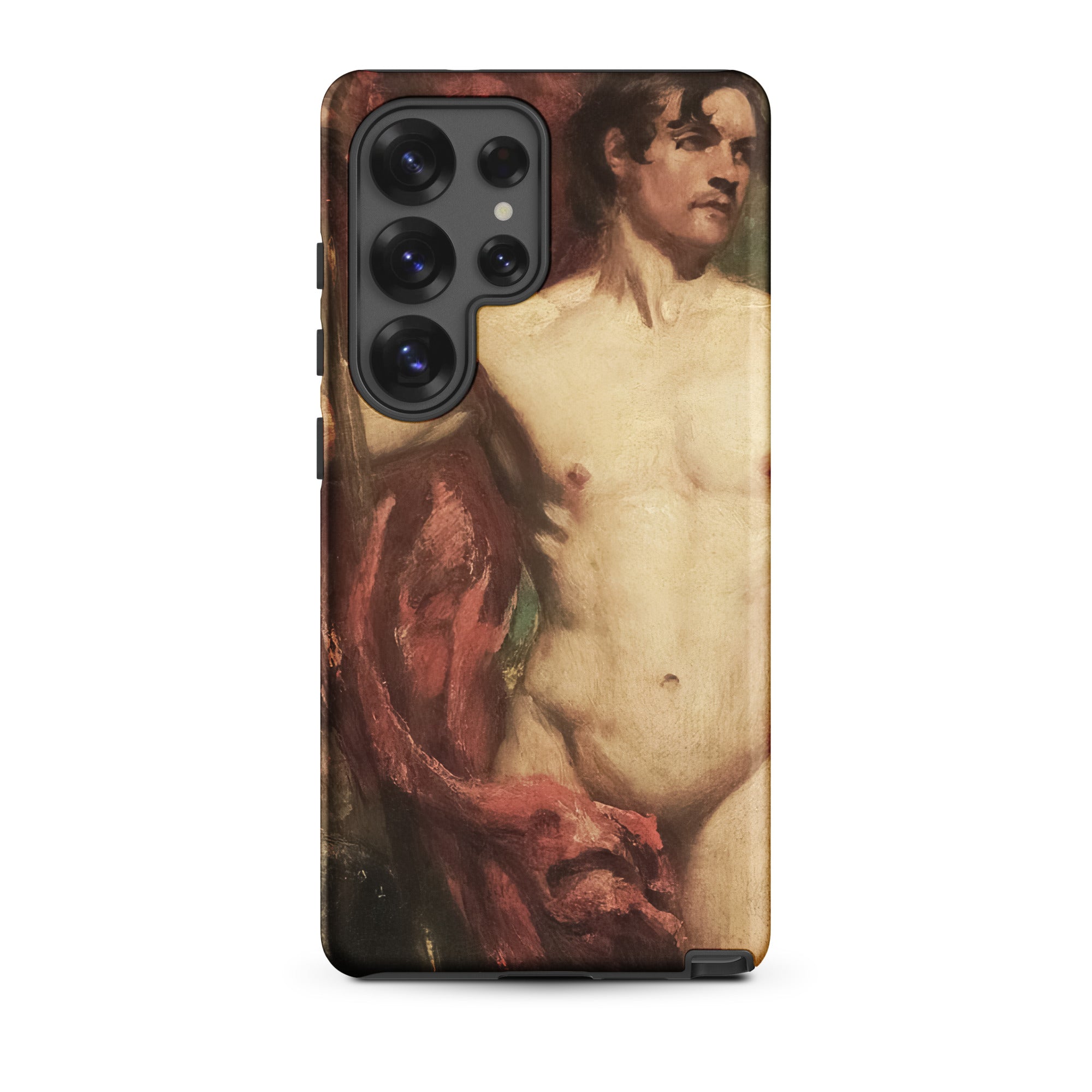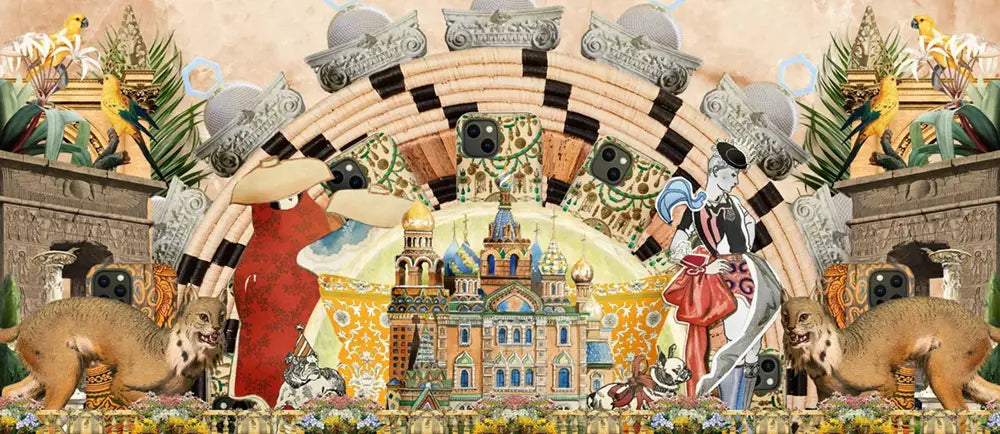Not all ghosts wear powdered wigs or clatter through time with swords drawn. Some shimmer in oil and pigment, reclining in glory, defiance and desire. They wait on canvas, under varnish—braced for the next gaze. And few wait more nakedly than those conjured by William Etty.
His work doesn’t whisper; it hums with the static of disrupted propriety. Amid the stilted reverence of 19th-century Britain, where even ankles sparked anxiety, Etty painted the human body as a battleground between ecstasy and decorum. Male and female, sacred and profane—he stripped mythologies bare to expose the trembling contradictions inside Victorian morality. A single torso could spark a riot of shame and awe.
Today, his nudes linger not as scandal but as questions: about beauty, about censorship, about the erotic weight of the gaze. They ask how art provokes, how flesh becomes symbol, how one brushstroke can sever the line between holiness and indecency. Step closer. These bodies breathe. And Etty—so long dismissed as a moral provocateur—is suddenly speaking in the modern tongue of cultural warfare, queer tension, gendered surveillance, and visual desire.
Key Takeaways
- A Yorkshire Visionary: Born in 1787, William Etty’s early years in York shaped a restless determination that propelled him from a printer’s apprentice to a trailblazer in the British art world.
- Unrelenting Focus on the Nude: Etty’s devotion to the unclothed human figure—male and female—both ignited critical fury and secured his reputation as a fearless innovator at a time when moral strictures were tight.
- Gendered Contradictions: Male nudes by Etty were heralded as heroic feats, while female nudes drew charges of indecency, revealing a Victorian society wrestling with its own double standards.
- Ties to the Venetian Masters: Inspired by artists like Titian and Rubens, Etty strove to match their luminescent color palettes and dramatic forms, while forging his own path through controversial subject matter.
- Modern Reassessments: Once fading into obscurity, Etty’s work has experienced a revival in contemporary scholarship—particularly its nuanced dialogue with sexuality, classical tradition, and cultural tensions.
Rustling Gingerbread Dreams: a Childhood in York
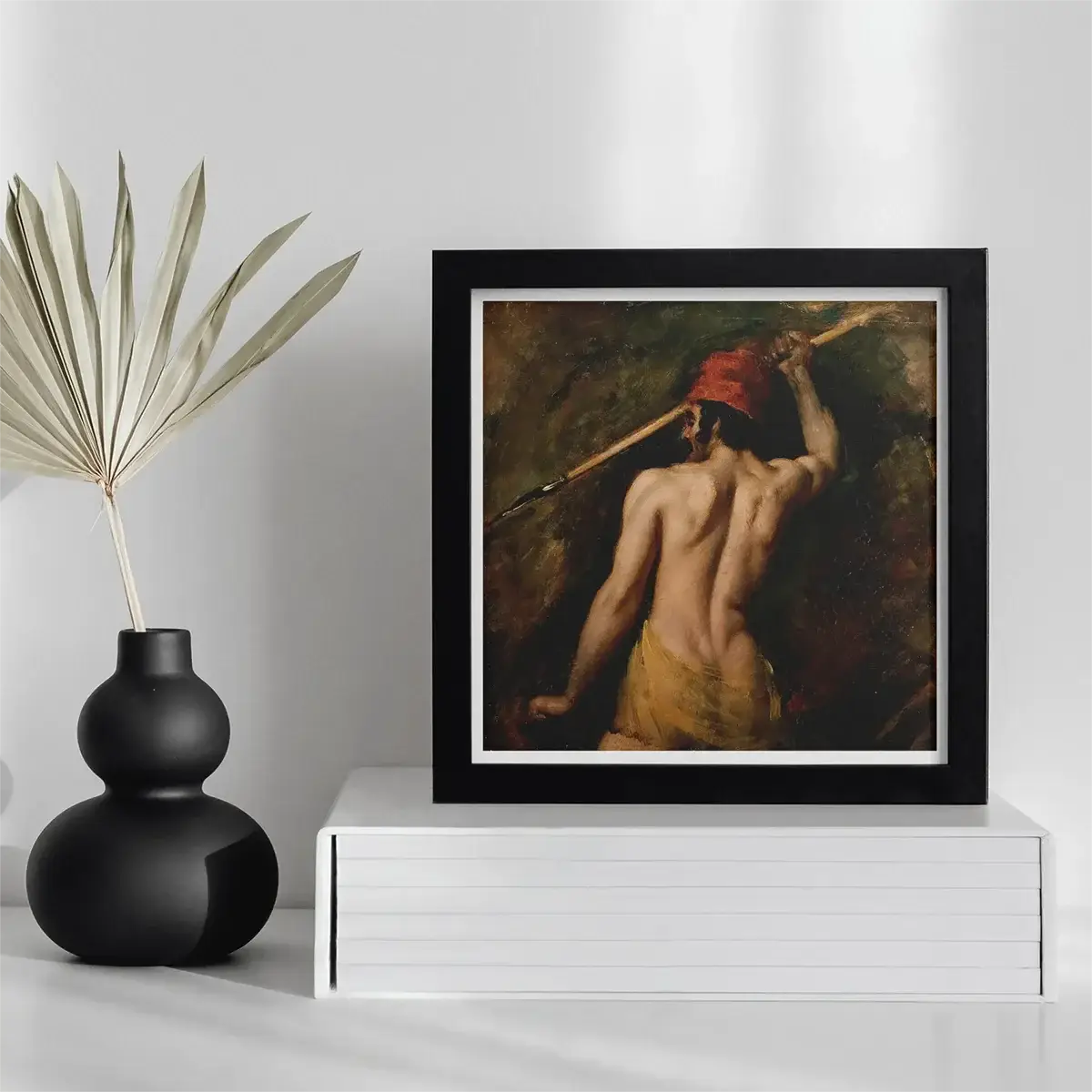
William Etty, A Greek Slave (1812)
Before the studio light, before the anatomical cast and the scandalous canvas, there was flour—sweet, brown, and dusting the floorboards of a York bakery. William Etty’s early life was a perfume of spice and ink: cinnamon coils, nutmeg bite, and the clatter of type blocks in a provincial pressroom. His father, Matthew Etty, balanced loaves and ledgers, while young William’s imagination fermented quietly between deliveries. The family made gingerbread; the boy dreamed of flesh and flame, color and contour, bodies lit from within.
Born in 1787, he was the seventh of ten children—an order both humble and visionary. Seventh sons are omens in myth; for Etty, this meant a kind of ancestral license to break rules, to chase visions not yet spoken aloud. While his siblings embraced the steady rhythms of practical trades, William’s hands twitched with hunger for something else. He was never just watching. He was studying. Seeing beyond what was there.
At age eleven, he was apprenticed to Robert Peck, a printer in Hull. There, among rollers, presses, and reams of rough paper, Etty learned discipline. Peck’s press, responsible for the Hull Packet, moved with the mechanical solemnity of order and dissemination. But what it printed—poems, dispatches, treatises—carried suggestion, emotion, risk. Etty, quiet-eyed, absorbed it all. Letters became lines. Pressure became precision. The same care he gave to placing lead type would one day shape the ligature of muscle beneath a painted arm.
Seven years passed in ink-stained apprenticeship. The printing trade offered safety, a journeyman’s future, but Etty’s pulse beat louder than pragmatism. In 1805, at just eighteen, he walked away from the stability of ink for the alchemy of oil paint. A leap from the factual to the figurative—from printed truth to painted nerve. He knew what was expected. He refused it. He wanted to paint not just bodies, but meaning housed in bodies—myth, conflict, divinity, desire. British history painting—epic, crowded, male—was his chosen altar. And he would approach it, not with fabric and sword, but with skin.
This wasn’t aesthetic escapism. It was ambition sharpened to a blade. History painting in Etty’s time was a genre of grandeur and nationalism. He saw in it a platform to challenge Victorian hypocrisy—not yet as crusade, but as instinct. Where others turned to allegory to veil their desires, Etty would one day place nakedness squarely at the center of the heroic. His journey began not in marble halls, but in a bakery’s warmth and a printer’s order—places where matter was shaped with hands and discipline ruled. But beneath that order: a boy already reaching toward the voluptuous chaos of art.
London’s Call: a Narrow Path to Artistic Grandeur
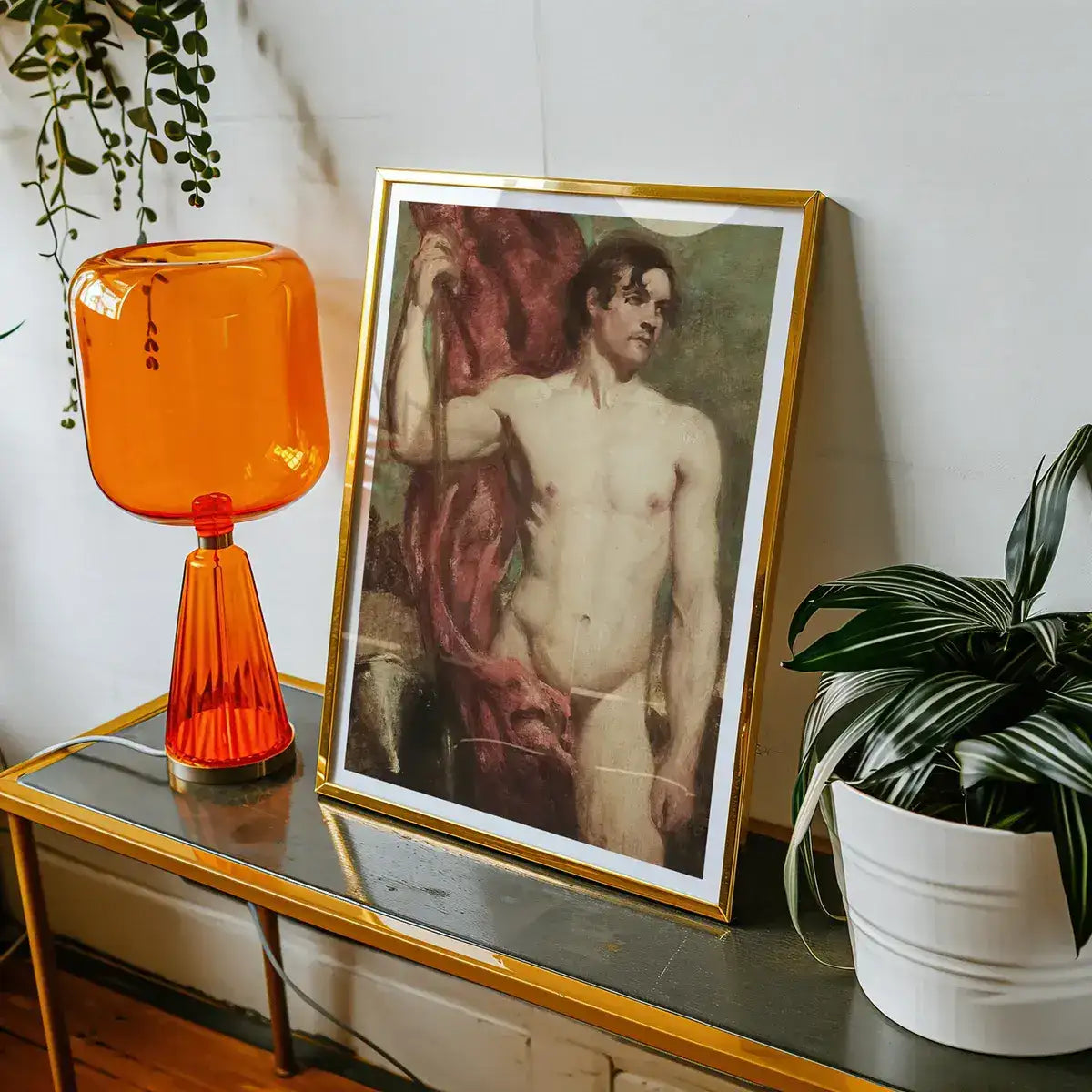
William Etty, Academic Study of a Male Nude as a Standard Bearer (1843-49 CE)
London didn’t beckon—it thundered. In the early 1800s, it was a city of gaslight flicker and soot-laced air, swollen with carriages, theories, and ambition. For William Etty, the leap from Yorkshire to the capital in 1807 was not just geographic—it was ontological. He entered a world that measured genius by classical allusion and anatomical fidelity, where reputation was as fragile as a pigment-stained brush.
The Royal Academy Schools accepted him that same year—a threshold few crossed, and fewer survived intact. Here, art was both aspiration and doctrine. Aspiring painters waded through the mythology of Greece and Rome, tethered to the idea that the grand was always draped, the heroic always clothed in metaphor. But Etty—already haunted by flesh—saw things differently. He wasn’t seduced by battle scenes or patriotic parables. He lingered in the life rooms, where bodies were stripped not for pleasure, but for truth.
These studies weren’t casual voyeurism. They were spiritual autopsies. Bone, sinew, shadow, skin—Etty traced them with reverence. Where his peers glanced and mimicked, he returned and repeated. The body became not just his subject, but his obsession, his gospel. And still, he lacked polish. His early submissions to the Academy’s exhibitions—awkward in form, uneven in composition—were dismissed, or worse, ignored.
Yet this didn’t deter him. Instead, Etty secured private lessons with Sir Thomas Lawrence, the reigning luminary of portraiture. Lawrence, a man whose brush caressed velvet and ambition with equal finesse, taught Etty how to compose not just images, but power. Under his guidance, Etty absorbed lessons in fluidity and form—but Lawrence’s social grace never quite adhered. Etty remained a solitary figure, bound not to salons but to the studio, to the graphite curve of a shoulder, the ochre stain of a belly’s arc.
As years passed, Etty grew—not into society, but into mastery. He found not applause, but focus. His colors began to glow with a Venetian heat; his compositions tightened like muscles before motion. His turning point came with The Coral Finder, a lush tangle of nude bodies in a mythic seascape. Critics were startled. Audiences gasped. He had arrived—and not quietly.
Still, prestige never diluted him. Even after he became a full Royal Academician in 1828—a title many used as exit visa from labor—Etty remained grounded. He continued working from the model, refining the human form with monastic persistence. Peers mocked him for “loitering among plaster casts.” But he knew better. For Etty, the life room was not remedial—it was sacred. It was the one place where honesty and anatomy met in a stare-down.
Where others painted to flatter, Etty painted to expose—not just flesh, but the tension between society’s gaze and its shame. In a culture that feared skin more than blood, he used oil and brush to pry open the locked doors of British decency, one bare shoulder at a time.
Brush With Venice: How Titian and Rubens Lit Etty’s Palette

William Etty, Academic Study of a Nude Man Tying His Sandal (1807-49 CE)
In the labyrinthine light of Venetian galleries, where saints and sinners dissolve in lacquered golds and thunderous reds, William Etty stood transfixed. Here, paint didn’t behave. It pulsed. Flesh glistened with a divine humidity, figures stretched across canvases like thunderclouds. This wasn’t decor—it was seduction by pigment.
For Etty, the pilgrimage to study the Old Masters was more than academic. It was spiritual transgression. Titian and Rubens didn’t merely influence him—they initiated him into a lineage where color was carnal, where form served not modesty but magnificence. These were painters who saw the human figure not as an object of shame, but as the altar itself.
Etty breathed in their saturated hues and unflinching bodies, absorbing how Titian allowed shadows to purr against skin and Rubens twisted form into muscular ballet. From these masters, Etty extracted not imitation but license—the courage to let bodies burst through allegory, to let pleasure become composition. And yet, he did not plagiarize. He metabolized.
Back in England, critics noticed. His flesh tones shimmered unnervingly, his compositions unspooled like mythic fever dreams. There were murmurs of "mannerism"—a coded insult, suggesting derivative flair rather than original fire. But Etty's work was not mere pastiche. If Titian was thunder and Rubens a storm surge, Etty was lightning hitting a Victorian roof. His nudes bore the chromatic inheritance of Venice, yes—but also the chill of a British room about to erupt.
His figures didn’t exist in escapist reverie. They tensed under the weight of their own exposure. Where Rubens’ bodies sprawled in opulent abandon, Etty’s felt watched. The blush on a shoulder wasn’t just pigment—it was accusation. The tension in a thigh was social, not anatomical. His brush did not seek to flatter flesh, but to press it—against time, against morality, against the viewer’s comfort.
This is what made his adoption of Venetian color so charged. He wasn’t cloaking sin in beauty. He was making beauty the sin. And in doing so, he blurred the line between admiration and transgression. His palette became a kind of heresy: luminous, defiant, dripping with both reverence and rebellion.
To accuse him of mimicking Titian was to miss the tremor. Etty didn’t want to be a Venetian. He wanted to be a contradiction—English in discipline, Venetian in flesh, modern in scandal. And he was.
Flesh-and-blood Canvas: Etty’s Bold Embrace of Nudity

William Etty, Male Nude with Arms Up-stretched (1828-30 CE)
To stand before a William Etty painting is to confront the body—not in repose, but in rupture. Every limb he rendered was an act of resistance, an affront to the cloistered decorum of Victorian England. In a culture where modesty masqueraded as moralism, Etty placed flesh squarely at the center of the canvas—luminous, unapologetic, and teetering on the edge of myth and menace.
His nudes were not ornamental. They were elemental. And they did not ask permission.
At a time when biblical themes were meant to sanctify, when myth was used as a velvet shroud to soften the shock of skin, Etty chose not to disguise but to declare. The figures he painted—Venus in the act of being adored, Judith in the moment before or after her revenge, Andromeda chained and trembling—glowed with a heat that surpassed allegory. They weren’t symbols. They were subjects.
Etty understood the risk. The Victorian eye sought virtue in drapery. The sight of a woman’s exposed back could scandalize a room. But instead of retreating, he leaned in—painting bodies that trembled with both narrative purpose and erotic charge. He did not present nudity as voyeurism but as confrontation: the body not just as form, but as discourse.
Each canvas was a friction point. Within the thick swirl of oils, you could feel the painter's conviction—his belief that the human body was a site of divine architecture. His nudes did not apologize; they announced. And when the public flinched, when critics recoiled, Etty stood by his brush with the biblical refrain: to the pure in heart, all things are pure.
But purity was not the reception he received. Viewers accused him of indecency, moral recklessness, even corruption. Art reviews snarled at his depictions of female nudity, finding them too real, too soft, too brazen. It didn’t matter that these bodies were embedded in classical or religious contexts. To his detractors, context was irrelevant. A breast was a breach. A curve was a crime.
Yet Etty kept painting.
He nestled these unclothed forms into grand historical dramas and mythic tableaux not to deflect critique, but to elevate the flesh—arguing, with brush and gaze, that the nude was not a threat to art’s dignity but its birthright. He saw no sin in skin. Only society did.
Even his male nudes—though more warmly received—carried this weight. Draped in the rhetoric of heroism and strength, they passed more easily into public acceptance. But they too bore the same attention to physical truth, the same commitment to form over flattery. If the female nude was judged as too seductive, the male was cloaked in virtue—a double standard that Etty refused to internalize, even as it followed him like a shadow.
In the end, his bold embrace of nudity was not about rebellion for its own sake. It was about fidelity—to the body as structure, to the myth as vehicle, and to painting as a sacred, sensuous act. Etty didn't just paint flesh. He painted its meaning.
Laurels for Men, Scorn for Women: the Gendered Divide
There was a forked tongue in Victorian art criticism, and William Etty learned to speak both its languages—one honeyed, one venomous. His male nudes were draped in admiration: “heroic,” “athletic,” “noble.” They were seen as anatomies of virtue, their muscle-bound torsos echoing Roman statuary and Homeric legends. These men, undressed, were monuments. But his female nudes—just as studied, just as mythologically framed—were condemned as threats. Not to morality, but to control.
Critics praised his brush for carving out “grand specimens of manly grace,” yet recoiled at the sight of a woman’s unclothed flank, her gaze meeting the viewer’s with anything but shame. In one hand, Etty held laurel wreaths; in the other, stones. This was not inconsistency—it was a revelation. The era’s aesthetics were gendered through and through. The naked male, idealized. The naked female, weaponized.
Scholar Sarah Burnage laid this hypocrisy bare: the same public that exulted Etty’s "heroic" men tore down his "seductive females" as morally corrupt. Their presence on canvas was not just provocative—it was perceived as contagious. An uncovered breast could poison a household. A reclining woman might undo the spiritual order of the Empire. The female body, in paint, had agency. And agency was dangerous.
Few works illuminate this better than Candaules, King of Lydia, Shews his Wife by Stealth to Gyges, One of his Ministers, as She Goes to Bed. The title alone is a mouthful of male privilege. The painting—drawn from Herodotus—depicts a king showing off his wife’s nakedness to another man without her knowledge. Etty rendered the scene with his usual mastery of form and tone: a soft bath of light, a composition full of tension and voyeurism. But while the narrative was classical, the outrage it stirred was contemporary.
Victorian critics exploded. The painting was branded “disgraceful,” “reprobate,” and worse. The fact that the story came from ancient history didn’t save it. In fact, it damned it further—because now Etty was accused not only of impropriety but of cloaking that impropriety in legitimacy. The naked queen wasn’t just a figure in a tale. She became a mirror—and what critics saw reflected back was their own unease with female autonomy, even imagined.
This episode didn’t slow Etty down. If anything, it sharpened his edge. He continued to paint women not as inert ideals but as complex presences—pleading, resisting, ascending, desiring. Yet he knew what they cost him. He could have stuck with wrestlers and warriors and been left in peace. But peace, for Etty, was never the point.
The gendered divide in the reception of his work exposes not only the period’s moral panic but its aesthetic cowardice. What the public feared wasn’t nudity—it was the female nude as a thinking, feeling, seeing subject. The male body, mythologized, could pass through untouched. The female body, however, was a live wire—and Etty, too often, the one blamed for plugging it in.
The Whirlwind of Criticism: Public Outcry and Private Defiance
If art is a mirror, William Etty’s was one too polished, too unforgiving. The critics didn’t just see brushwork—they saw a threat. His paintings became the flashpoint for a public simmering with moral anxiety, a culture built on repression yet obsessed with exposure. Each exhibition was a ritual backlash, each canvas a fresh incitement.
The newspapers attacked with ecclesiastical ferocity. Etty wasn’t merely criticized—he was excoriated. His name came wreathed in adjectives like “lascivious,” “disgraceful,” “unwholesome.” It wasn’t the subject matter, they claimed. It was his mind. One reviewer wrote that Etty lacked the “chastity of mind” required to depict nudity without corruption, accusing him of painting women who “sacrifice the feelings of her sex for bread.” Another denounced him as a danger to the public—his art capable of infecting viewers with moral decay.
The subtext was clear: female nudity, especially as Etty painted it—unidealized, emotionally present, unconcealed—was a contagion. His brush, they feared, could undo the careful scaffolding of propriety. His canvases weren’t hidden in elite salons but hung in public exhibitions, accessible to men, women, children. The anxiety wasn’t just about flesh—it was about audience. What if someone looked and understood?
Etty, for his part, never flinched. He returned volley after volley of condemnation with a single phrase: To the pure in heart, all things are pure. A biblical defense—not coy, not evasive, but absolute. He positioned himself not as a corrupter but as a seer, someone who saw the divine encoded in muscle, curve, and skin. The problem, he insisted, was not in the paint but in the eye that judged it.
Yet even this defense was a kind of resignation. Etty knew he was walking a razor’s edge. His use of myth and scripture was strategic—a moral scaffolding draped around figures that would otherwise be too raw, too present. The stories were not excuses but frames, offering his nudes a tenuous legitimacy. Still, it rarely sufficed. The more he painted women in luminous repose or mythic torment, the more the critics circled, baying for repentance.
But there was no repentance. Etty’s private defiance was monastic, methodical. He did not lash out in polemic or posture for fame. He retreated to the life room. Day after day, he painted—wrestling with form, with light, with the tension between reverence and rebellion. While his peers climbed into fashionable society, he returned to the same models, the same rituals of study. His persistence wasn’t theatrical. It was devotional.
And that devotion, over time, became a kind of armor. Etty never stopped defending the nude—not because it was scandalous, but because it was sacred. He refused to let his work be reduced to titillation or dismissed as perversion. To him, every painted body was an argument for complexity, for beauty, for seeing beyond the veil of fear. In the thunderstorm of Victorian censorship, Etty stood still—soaked, vilified, unrepentant.
Painted Desires: Sexuality and the Lifelong Bachelor
There are artists who marry the world, and those who remain tethered to a private cosmos—half solitude, half obsession. William Etty never married. He left behind no known romances, no confessional letters blooming with names or longing. But his canvases pulse with intimacy. Not the kind scrawled in diaries—but the kind whispered in pigment and posture, the unspeakable coded into contour and light.
In his lifetime, bachelorhood raised eyebrows. In Victorian England, to remain unmarried was to exist in a fog of suspicion—especially if you painted bodies that shimmered with attention, especially if those bodies were male. And Etty painted male nudes often. Not just as studies in anatomy, but as figures rendered with tenderness, tension, and deliberate care. They stand not only as mythic forms but as invitations—arms outstretched, muscles taut, bathed in theatrical shadow.
Was it admiration? Devotion? Desire?
Modern scholars, equipped with the lenses of queer theory, have returned to Etty’s oeuvre with sharpened eyes. Jason Edwards, among others, has argued that the heroic male figures once heralded for their classical integrity may, in fact, flicker with homoerotic charge. Not in parody. Not in scandal. But in the honest awe of one man painting another—flesh not as spectacle but as site of longing, possibility, and fracture.
What once scandalized—his female nudes—now reads, to some, as the era’s predictable discomfort with women’s visibility. But the male nudes have become newly complex: previously celebrated for their idealized strength, they now ripple with layered subtext. Desire, admiration, identification—Etty’s brush does not resolve these forces. It lets them coexist. The gaze in his paintings is never neutral. It hovers, aches, lingers.
And yet, there is restraint. Etty did not paint lovers. He did not write manifestos. His work lacks the flamboyance or confessional urgency we now associate with queer expression. But that, too, is telling. In a time when to name desire was to risk obliteration, Etty left his queerness—if queerness it was—in the brushstroke. A muscle painted too reverently. A thigh glowing too long beneath the light.
His bachelorhood becomes part of the canvas. Not evidence, but echo. The long hours in the life room, the repeated return to the male form—not as object, but as ideal—suggest a closeness, a curiosity, perhaps a reverence that conventional language refused him. His refusal to marry wasn’t a statement. It was a silence, shaped by the era’s constraints and the painter’s own internal climate.
We may never know what Etty wanted, whom he loved, or how he named his hunger. But we can read his work as a kind of longing in disguise: a yearning stretched across torsos and mythic arms, a soft rebellion in the heroic nude. His painted desires remain—unanswered, but not unread.
Beyond Nudity: the Subtle Themes and Hidden Depths
Beneath the glint of flesh, beneath the scandal and the sheen of oil, William Etty was always painting more than bodies. He was constructing mythologies of mercy and power, staging tableaus where desire collided with morality, where beauty disguised a deeper kind of reckoning. His work, often dismissed as erotically single-minded, is laced with unexpected gravity.
Take The Combat: Woman Pleading for the Vanquished. At first glance, it’s classical melodrama—figures tangled in motion, robes swept into the wind of narrative urgency. But in the woman’s outstretched hands, in the supplicant curve of her back, there is more than theatrical gesture. There is empathy rendered monumental. Her cry is not decorative. It’s structural. Etty pulls from Hellenistic sculpture—its agony, its poise—but injects it with emotional truth. This isn’t just homage. It’s an argument: that pathos can be as heroic as conquest.
In another key, there is The Wrestlers, painted in 1840—the same year the World Anti-Slavery Convention met in London. Two men locked in muscular conflict: one white, one Black. Their struggle is physical, yes, but also symbolic. To Etty’s contemporary audience, the scene may have read as a classical contest, a mere academic exercise in torsion and composition. But to modern eyes, the implications are more complex. The racial dynamic crackles. What does it mean to show Black and white bodies entwined in physical parity at a moment when slavery had only just been abolished in Britain’s empire?
Art historian Sarah Victoria Turner suggests the painting gestures toward Britain’s troubled conscience—its attempt to grapple with freedom through aesthetic allegory. Etty, rarely overt in his politics, seems here to acknowledge the nation’s historical rupture. The bodies don’t preach. They resist. Their locked forms become emblems of unresolved struggle, the frame a silent witness to an empire’s moral reckoning.
This is what Etty understood—perhaps better than his critics ever could. That history painting wasn’t just about mythology or grandeur. It was about tension. About using form and figure to ask questions too volatile for words. His canvases weren’t just studios of anatomy. They were theatres of ambiguity.
Even his more traditionally “beautiful” works, like Venus and her Satellites, hum with dissonance. The pleasure is not uncomplicated. There’s vulnerability in the curve of a hip, a warning in the set of a gaze. These women are never just passive ideals. They reflect power, fragility, even resistance—subtle signals encoded in posture, light, and gaze.
Etty’s legacy, then, is not just the nude. It’s the emotional architecture beneath it. The stories that unfold in shadow and gesture. The bodies that refuse to be only bodies.
In a society obsessed with surface, he painted substance. And in doing so, he proved that skin, when rendered with care and complexity, could bear the full weight of myth, meaning, and memory.
Return of the Shadow Figures: Etty Rediscovered
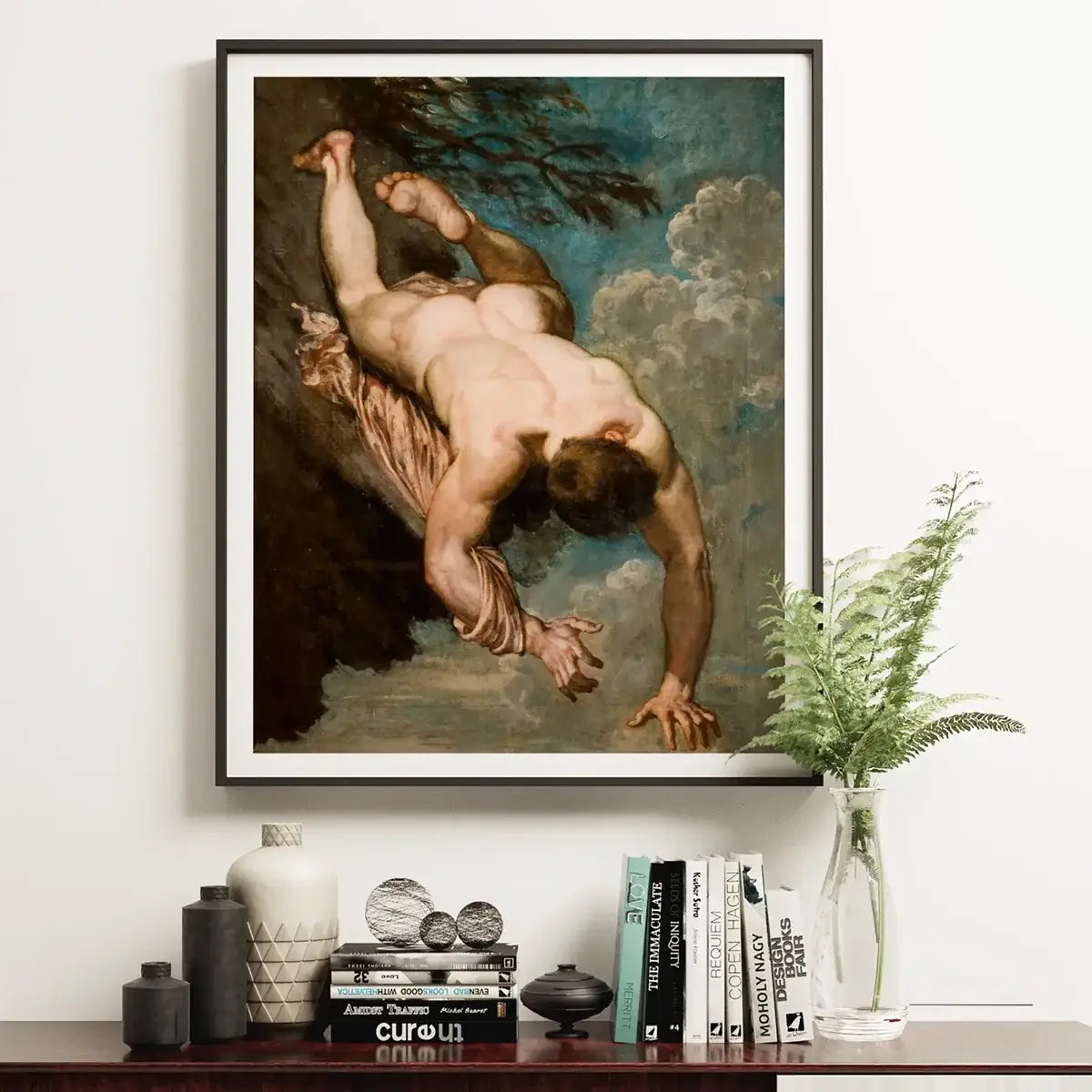
William Etty, Manlius Hurled from the Rock (1818 CE)
For decades, William Etty’s name gathered dust—spoken only in footnotes, eclipsed by new schools, new scandals. The nudity that once convulsed Victorian nerves fell out of favor not for its transgression, but for its context. Taste moved on. The flesh yellowed beneath varnish. And the painter who had once caused a moral earthquake slipped into the half-light of academic obscurity.
But shadows don’t vanish. They wait. And in the 21st century, Etty began to stir again—first in whispers, then in frames. A major turning point came with William Etty: Art and Controversy, an exhibition mounted at York Art Gallery. There, under clean lights and modern eyes, the painter’s legacy unfurled anew—not as relic, but as rupture.
Critics reexamined his work not through the lens of shame but of subtext. What once seemed salacious was now read as a confrontation with Victorian repression. What had been dismissed as indulgent became a study in the ethics of depiction. Etty’s canvases didn’t simply reemerge—they were recontextualized.
The show didn’t flinch. It leaned into contradiction. Side by side, visitors saw paintings of sun-drenched torsos and mythological lovers, but also essays on censorship, gender politics, and colonial legacies. Curators pulled Etty’s technique into focus—his Venetian-influenced color, his radical commitment to life drawing—as well as the social stakes of his subject matter. He wasn’t just reviving the nude. He was challenging Britain’s cultural thermostat.
And scholars arrived, armed not with moral panic but with theory. Feminist, queer, postcolonial frameworks reframed his work as palimpsests of desire, power, and resistance. The male nudes, once seen as uncontroversial, now glowed with erotic charge. The female nudes, once condemned, emerged as flashpoints in the history of the gaze. Each body he painted became a historical sensor—reactivated by new attention, new touch.
This return was not redemptive. It was revelatory. Etty had never needed saving—only seeing.
The rediscovery also revealed the deep tension in his practice: a man trained in the classical tradition, moving through a society that feared its own reflection. He was not simply a provocateur. He was an artist trying to thread the needle between truth and tolerance, between beauty and blame. In revisiting his work, we don’t just recover a neglected painter—we resurface the conversations he provoked, the ones Victorian critics tried so hard to silence.
There’s a reason these paintings resonate now. The body remains a battleground. The politics of nudity, gender, and public decency still spark censure, protest, policy. And Etty—long entombed as a cautionary tale—suddenly reads as prophet. His scandal was never about indecency. It was about power: who gets to see, who gets to be seen, and who controls the terms.
That’s the gift of return. Not resurrection, but re-reading. Not forgiveness, but friction. And in the soft shine of a museum light, William Etty’s shadow steps forward again—not cleansed, but clarified.
New Horizons in Scholarship: a Moral and Aesthetic Reckoning
When the scaffolding of Victorian morality finally collapsed, William Etty’s art emerged from the rubble not as ruin, but as relic—charged, contested, recharged. Where critics once saw obscenity, scholars now see inquiry: a painted dialectic of beauty, shame, and cultural surveillance.
Modern viewers encounter his canvases with a different literacy. The luminous flesh once branded indecent now invites layered interpretation. His color—the Venetian inheritance once ridiculed as excess—is praised for its chromatic courage. And the nude, far from scandal, becomes a mirror reflecting how bodies have been policed, politicized, and fetishized across centuries.
Queer studies, especially, have reopened Etty’s work. Muscled men once admired as paragons of classical form are re-read as homoerotic emblems: bodies posed not just for anatomy, but for longing. These were not neutral renderings. They gazed back. They asked to be seen.
Feminist critique, too, peels back the Victorian sneer. The so-called “seductive females” no longer read as provocations, but as flashpoints—sites where patriarchal discomfort projected sin onto skin. Today, those same figures can be understood as witnesses to a culture anxious about women’s visibility, power, and physical autonomy.
The reassessment isn’t revisionist—it’s reparative. It doesn’t sanitize Etty’s contradictions; it exposes them, makes them legible. And in doing so, it invites viewers to reflect not just on the artist, but on the long arc of aesthetic judgment: who gets to paint the body, who gets to view it, and what power circulates in that looking.
The Ebb and Flow of Fortune: Exile and Exhumation
William Etty’s career followed the rhythm of scandal—rising with shock, retreating with disdain. By the time he died in 1849, the very qualities that had once made him infamous—his luminous flesh tones, his relentless commitment to the nude—had rendered him unfashionable. The tide had turned. A new era was arriving, clothed in Realism, restraint, and moral fatigue.
His paintings, once magnets for public scrutiny, were quietly shelved. The next generation had little appetite for controversy framed in myth. In a Britain now captivated by industrial progress and imperial spectacle, Etty’s naked bodies—framed in ancient allegory and moral ambiguity—felt like echoes from a past best ignored.
Yet absence is not erasure. Over time, his works persisted in storage, in whispered reference, in catalogues of the unfashionable. And slowly, a shift began. Scholars returned, not to gawk but to question. Was Etty’s fall a matter of taste—or of cultural suppression?
As new critical lenses emerged, so too did Etty’s relevance. The once-damning elements of his art—nudity, queerness, visual provocation—became entry points for reinterpretation. Female forms, once branded immoral, were seen anew as projections of Victorian anxiety. Male nudes, once heroic, now shimmered with homoerotic undertone.
In the flicker of these revised gazes, Etty was not resurrected but reframed. His exile, it turned out, was temporary. His scandal—timed too early—now reads as prelude to questions we’re still asking.
A Complex Legacy: What William Etty Leaves Behind
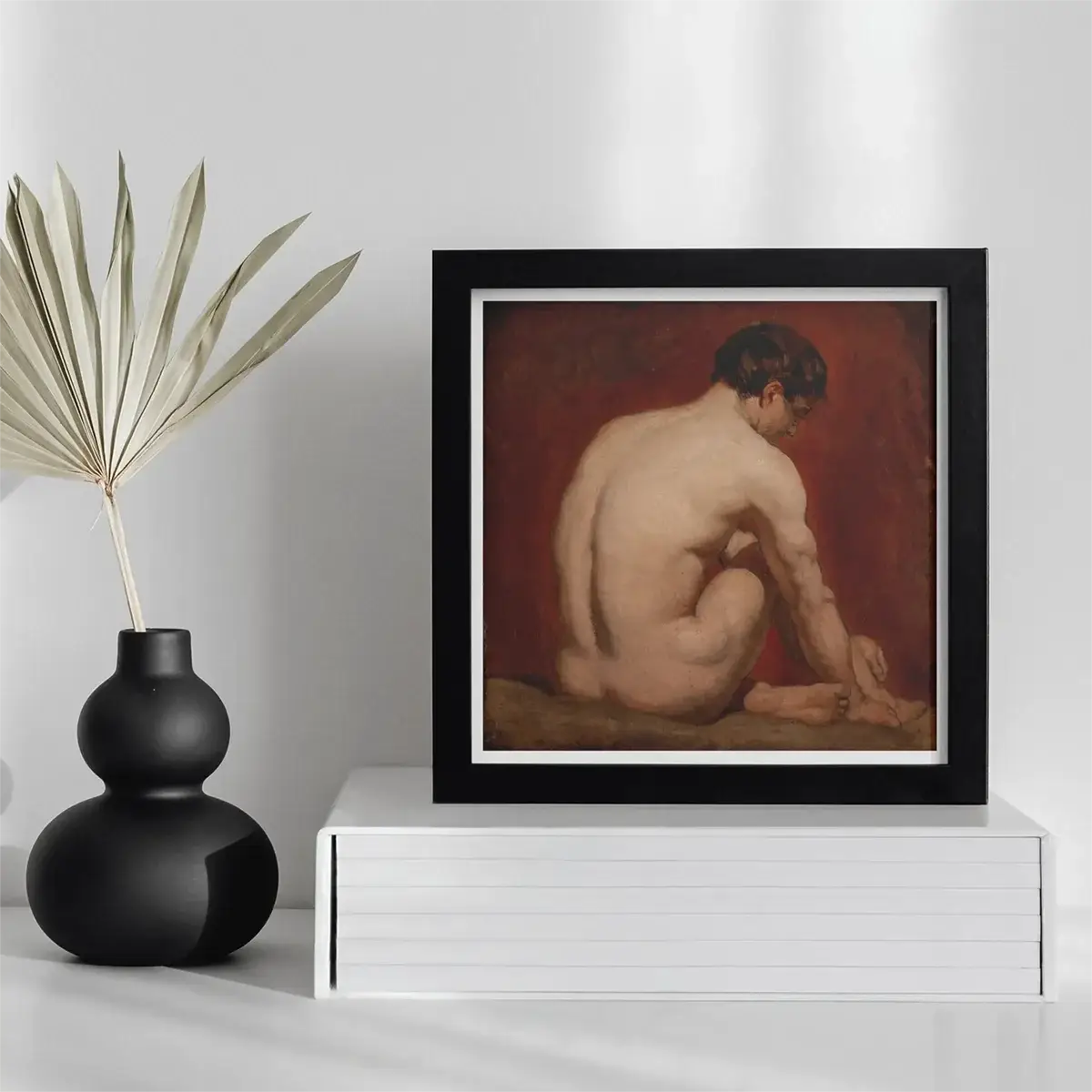
William Etty, Male Nude Kneeling from the Back (1840 CE)
William Etty occupies a peculiar place in British art—a name known not for a school, nor a movement, but for a refusal. He never founded followers, never birthed a manifesto. Yet he disrupted more than most who did. His work resisted containment: not classical, not romantic, not moralist, not rebel. Just Etty. Singular. Unruly. Unclaimed.
He was a painter obsessed with form but unmoved by fashion, an academic who lived in the margins of his own success. His election to the Royal Academy should have solidified his legacy. Instead, it punctuated the beginning of his critical decline. Time passed. Trends shifted. And the man who once made headlines with painted skin slipped into the footnotes.
Yet his paintings endure—not merely as historical artifacts, but as portraits of an artist out of sync with the systems around him. His attention to the human figure was not licentiousness, nor merely admiration. It was study, ritual, and belief. Each body he rendered feels less like a character, more like an argument: for stillness, for complexity, for the right to look and be looked at without distortion.
Today, he remains difficult to pin down. That difficulty is his contribution. In an age quick to categorize, Etty reminds us that art does not always obey the binaries we build for it—sacred or profane, radical or conservative, pure or perverse.
He leaves behind the bodies, yes. But more than that: a body of work that resists conclusion.
Reframing Etty in the Modern Eye
In the end, William Etty stands as both cautionary tale and celebrated prodigy—an artist whose desire to paint the human form in luminous honesty thrust him into a moral quagmire. Instead of shrinking back, he stepped forward, offering biblical quotations and painting after painting as a kind of credo. His brush dared to show what many around him labored to conceal, forcing an entire generation to confront the potency of art when it unveils the body without contrivance or shame.
Though... Etty never left a clear statement of purpose. No manifesto, no flamboyant declarations. What survives are the paintings themselves—dense with anatomy, myth, and unspoken tension. In them, scholars and viewers alike find a kind of time capsule: an artist straining against the moral limits of his day, without quite breaking them. He did not explode the norms—he eroded them, brushstroke by brushstroke.
His work has become a site of layered return. For queer theorists, it offers coded intimacy. For feminist historians, it reflects the ways female bodies were burdened with symbolic threat. For contemporary curators, it’s a chance to surface the complexities of past censorship—and its echoes in present-day debates over expression.
Etty’s refusal to conform—to narrative clarity, to visual modesty, to ideological alignment—makes him newly resonant. We live in a moment where the body is again contested terrain: in courtrooms, in media, in galleries. What Etty painted still touches that nerve.
He does not instruct. He lingers. And in that lingering, his work becomes a site of confrontation not just with the past—but with our own ways of seeing.




